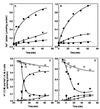Evidence for Na(+) influx via the NtpJ protein of the KtrII K(+) uptake system in Enterococcus hirae
- PMID: 10762252
- PMCID: PMC111314
- DOI: 10.1128/JB.182.9.2507-2512.2000
Evidence for Na(+) influx via the NtpJ protein of the KtrII K(+) uptake system in Enterococcus hirae
Abstract
The ntpJ gene, a cistron located at the tail end of the vacuolar-type Na(+)-ATPase (ntp) operon of Enterococcus hirae, encodes a transporter of the KtrII K(+) uptake system. We found that K(+) accumulation in the ntpJ-disrupted mutant JEM2 was markedly enhanced by addition of valinomycin at pH 10. Studies of the membrane potential (DeltaPsi; inside negative) by 3, 3'-dihexyloxacarbocyanine iodide fluorescence revealed that the DeltaPsi was hyperpolarized at pH 10 in JEM2; the DeltaPsi values of the parent strain ATCC 9790 and JEM2, estimated by determining the equilibrium distribution of K(+) or Rb(+) in the presence of valinomycin, were -118 and -160 mV, respectively. DeltaPsi generation at pH 10 was accomplished by an electrogenic Na(+) efflux via the Na(+)-ATPase, whose levels in the two strains were quite similar. Na(+) uptake driven by an artificially imposed DeltaPsi (inside negative) was missing in JEM2, suggesting that NtpJ mediates Na(+) movement in addition to K(+) movement. Finally, the growth of JEM2 arrested in K(+)-limited high-Na(+) medium at pH 10 was restored by addition of valinomycin. These results suggest that NtpJ mediates electrogenic transport of K(+) as well as Na(+), that it likely mediates K(+) and Na(+) cotransport, and that Na(+) movement via NtpJ is the major Na(+) reentry pathway at high pH values.
Figures







Similar articles
-
The ntpJ gene in the Enterococcus hirae ntp operon encodes a component of KtrII potassium transport system functionally independent of vacuolar Na+-ATPase.J Biol Chem. 1996 Apr 26;271(17):10042-7. doi: 10.1074/jbc.271.17.10042. J Biol Chem. 1996. PMID: 8626559
-
Structure and function of vacuolar Na+-translocating ATPase in Enterococcus hirae.J Bioenerg Biomembr. 1999 Feb;31(1):7-14. doi: 10.1023/a:1005499126939. J Bioenerg Biomembr. 1999. PMID: 10340844 Review.
-
Catalytic properties of Na(+)-translocating V-ATPase in Enterococcus hirae.Biochim Biophys Acta. 2001 May 1;1505(1):75-81. doi: 10.1016/s0005-2728(00)00278-4. Biochim Biophys Acta. 2001. PMID: 11248190 Review.
-
Purification and reconstitution of Na+-translocating vacuolar ATPase from Enterococcus hirae.J Biol Chem. 1997 Oct 3;272(40):24885-90. doi: 10.1074/jbc.272.40.24885. J Biol Chem. 1997. PMID: 9312089
-
Enterococcus hirae vacuolar ATPase is expressed in response to pH as well as sodium.FEBS Lett. 1999 Jul 2;454(1-2):67-70. doi: 10.1016/s0014-5793(99)00776-0. FEBS Lett. 1999. PMID: 10413097
Cited by
-
Identification of Listeria monocytogenes genes involved in salt and alkaline-pH tolerance.Appl Environ Microbiol. 2003 Jun;69(6):3137-43. doi: 10.1128/AEM.69.6.3137-3143.2003. Appl Environ Microbiol. 2003. PMID: 12788708 Free PMC article.
-
Membrane region M2C2 in subunit KtrB of the K+ uptake system KtrAB from Vibrio alginolyticus forms a flexible gate controlling K+ flux: an electron paramagnetic resonance study.J Biol Chem. 2010 Sep 3;285(36):28210-9. doi: 10.1074/jbc.M110.139311. Epub 2010 Jun 23. J Biol Chem. 2010. PMID: 20573964 Free PMC article.
-
Potassium and sodium transport in non-animal cells: the Trk/Ktr/HKT transporter family.Cell Mol Life Sci. 2010 Aug;67(15):2511-32. doi: 10.1007/s00018-010-0317-7. Epub 2010 Mar 24. Cell Mol Life Sci. 2010. PMID: 20333436 Free PMC article. Review.
-
Minimization of extracellular space as a driving force in prokaryote association and the origin of eukaryotes.Biol Direct. 2014 Nov 18;9(1):24. doi: 10.1186/1745-6150-9-24. Biol Direct. 2014. PMID: 25406691 Free PMC article.
-
The Ktr potassium transport system in Staphylococcus aureus and its role in cell physiology, antimicrobial resistance and pathogenesis.Mol Microbiol. 2013 Aug;89(4):760-73. doi: 10.1111/mmi.12312. Epub 2013 Jul 17. Mol Microbiol. 2013. PMID: 23815639 Free PMC article.
References
-
- Abrams A. The proton-translocating membrane ATPase (F1Fo) in Streptococcus faecalis. In: Martonosi A N, editor. Enzymes in biological membranes. 2nd ed. Vol. 4. New York, N.Y: Plenum Press; 1985. pp. 177–193.
-
- Bakker E P. Accumulation of thallous ions (Tl+) as a measure of the electrical potential difference across the cytoplasmic membrane of bacteria. Biochemistry. 1978;17:2899–2904. - PubMed
-
- Bakker, E. P., and F. M. Harold. 1980. Energy coupling to potassium transport in Streptococcus faecalis: interplay of ATP and the protonmotive force. 255:433–440. - PubMed
-
- Diatloff E, Kumar R, Schachtman D P. Site directed mutagenesis reduces the Na+ affinity of HKT1, an Na+ energized high affinity K+ transporter. FEBS Lett. 1998;432:31–36. - PubMed
Publication types
MeSH terms
Substances
LinkOut - more resources
Full Text Sources
Medical
Molecular Biology Databases

